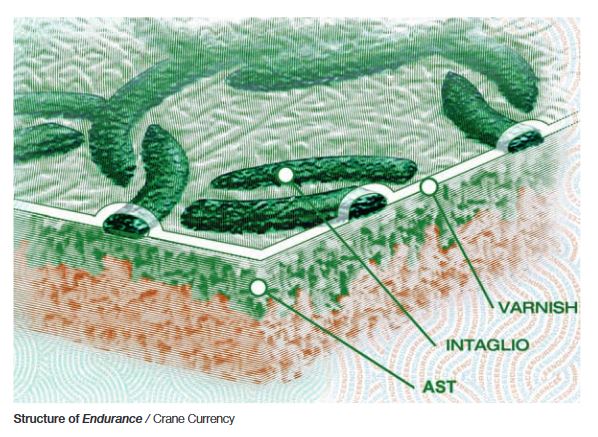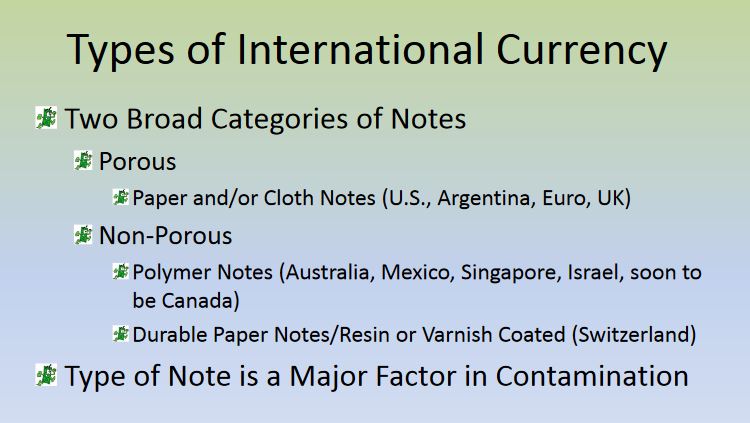Banknotes and Coronavirus
A few days ago I was walking in the park near our house with my wife and kids. Their schools were already cancelled and we wanted them to stretch their legs. On the path in front of me I saw a fresh $20 bill.
My first thought was that this was some sort of social experiment. Someone was secretly monitoring me to test if I would take it for myself or would try and find its owner. I’ve found $5 and $20 bills before, and this is always my first reaction.
My second reaction caught me by surprise. Is that bill loaded with coronavirus? Should I just leave it on the ground? Luckily, I never had to make a decision. The person who had lost it was backtracking, and I pointed it out to them.
But how justified was my worry?
There are few objects in the world that are more widely touched and manipulated than cash. It’s no wonder that as the coronavirus travels around the globe, potential transmission by banknotes has become an issue.
In this post I’m going to review what the authorities like central banks have done up till now with the banknotes they issue. And then I’ll discuss what science has to tell us about banknotes and pathogens.
The response from central bankers
The current pandemic is being caused by the severe acute respiratory syndrome coronavirus 2, or SARS-CoV-2. It first emerged in the Chinese city of Wuhan in December.
Beginning in mid-February, banks in virus-hit parts of China were ordered by the People’s Bank of China, China’s central bank, to withdraw potentially-infected cash from circulation. All notes received from hospitals, markets, and buses were to be sent to the central bank for destruction. Remaining banknotes were to be disinfected using ultraviolet or heat treatments and stored for seven to 14 days before recirculation.
South Korea also announced measures. On February 19, the Bank of Korea announced that to help prevent the spread of the coronavirus, it would no longer be accepting banknotes and coins from overseas. On February 24 it began routinely superheating notes to 150 degrees Celsius for two to three seconds. And on March 6 it announced that all cash coming to the central bank from local banks would be quarantined for two weeks.
In early March, Iranian authorities encouraged the public to avoid banknotes.
The Federal Reserve began quarantining incoming dollar banknotes from Asia on February 21. Saudi Arabia recently began isolating all banknotes coming back into the kingdom from banks and money transfer companies.
In Hungary, the central bank reported that it was isolating billions worth of banknotes for two weeks, then shrink wrapping them and sending them through a 160°C tunnel. Kuwait too has begun to isolate used banknotes for at least four weeks before recirculating them into the economy.
The World Health Organization’s stance
As for the World Health Organization (WHO), it issued the following graphic on February 19:
FACT: The risk of being infected with the new #coronavirus by touching coins, banknotes, credit cards and other objects, is very low https://t.co/BOuqHUDjwL#COVID19 #KnowtheFacts pic.twitter.com/CkrTYNanV5
— World Health Organization Western Pacific (@WHOWPRO) February 19, 2020
On March 3 TheTelegraph, a British newspaper, published an article claiming that a WHO spokesman had said that banknotes may be spreading the new coronavirus, and so people should try to use contactless payments instead:
“The World Health Organization said the British public should exercise care when handling potentially infectious banknotes. Asked whether banknotes could be spreading coronavirus, a WHO spokesman replied: “Yes it’s possible and it’s a good question. We know that money changes hands frequently and can pick up all sorts of bacteria and viruses and things like that.
“We would advise people to wash their hands after handling banknotes, and avoid touching their face. … When possible it’s a good idea to use contactless payments.”
The WHO later claimed that it had been misrepresented:
“WHO did NOT say banknotes would transmit COVID-19, nor have we issued any warnings or statements about this,” [WHO spokesperson] Chaib said in an email. “We were asked if we thought banknotes could transmit COVID-19 and we said you should wash your hands after handling money, especially if handling or eating food.” Doing so is “good hygiene practice,” she added."
That illustrates the institutional response. But what do scientists have to say about the interaction of banknotes with viruses such as SARS-CoV-2?
We know a lot about bacteria on banknotes
There have been a number of studies that attempt to analyze used (i.e. circulated) banknotes to detect for pathogens. Infectious microorganisms, or pathogens, can be divided into several categories: bacteria, viruses, parasites, or fungi. In a 2014 review paper ‘Paper money and coins as potential vectors of transmissible disease’, Angelaki et al point to around a dozen or so studies by scientists around the world. These include:
•Bacterial contamination of Saudi “one” Riyal paper notes (Al-Ghamdi et al, 2011)
•A study of bacterial contamination of Ghanaian currency notes in circulation (Tagoe et al, 2011)
•Bacterial contamination of Indian currency notes (Elumalai et al, 2012)
However, not one of the studies listed in Agnelaki et al’s review paper found viruses on previously-circulated money. I haven’t been able to determine why scientists know so little about the presence of viruses on used banknotes. Perhaps the lack of knowledge is due to the fact that viruses are much smaller, and therefore harder to find. Or maybe scientists have simply chosen to focus on testing circulated banknotes for bacteria.
In any case, while we have plenty of hard data about the bacteria on our banknotes, we know almost nothing about the presence of viruses like influenza or SARS-CoV-2 on previously-circulated cash.
In lab conditions, viruses survive for many days on currency
Some of the only scientific knowledge we have about viruses on banknotes comes from a 2007 study by a group of Swiss scientists. Rather than testing an existing note for the presence of a virus, the researchers introduced a virus onto a banknote under lab conditions. More specifically, Swiss banknotes were contaminated with various types of influenza and monitored to see how long the viruses would last.
At high concentrations, influenza A viruses survived up to three days on Swiss banknotes. When the scientists combined influenza A with respiratory mucus, survival time increased dramatically to up to 17 days. It seems that viruses like influenza are able to use human mucous as a protective medium. The authors concluded their study with this:
“Given the unexpected stability of influenza virus in this nonbiological environment, our current understanding of the conditions favoring influenza virus survival needs to be revised, particularly in the context of pandemic preparedness."
Keep in mind that the scientists only focused on the influenza virus, not SARS-CoV-2. Nor did it study many of the other vital steps to infection, including the ease by which viruses can be transferred from a banknote onto someone’s fingers, and from there into the respiratory tract. But it is worth keeping in mind that viruses can stick around for a long time on a banknote (in this case a Swiss one).
From banknote to finger
I’ve found one other study that investigates the interaction of viruses and banknotes. In 2014, a group of American scientists tested how easily pathogens such as viruses could be transferred from objects to fingers in laboratory conditions. They used a number of mediums including plastic, glass, ceramic, polyester, and also currency. The surface of each was infected with various types of viruses and bacteria. The scientists then tested how easily these pathogens could be transferred onto a finger. (Note that they did not test SARS-CoV-2).
Non-porous surfaces like acrylic and glass showed the highest transfer efficiencies. Put differently, these surfaces made it easy for viruses to be moved onto fingers. Non-porous surfaces were less conducive to transferring pathogens. U.S. paper currency, a non-porous surface, had the lowest transfer efficiency of all the objects studied. The authors suggested that “porous surfaces may entrap organisms within their matrix and provide a much greater surface area for attachment."
So for those who are worried about viral transfer from various surfaces, it would seem that before fretting over US$100 bills, best to prioritize one’s contact with plastic, glass, and stainless steel.
There is a big weakness with both the Swiss and American studies. They used their own domestic legal tenders, Swiss banknotes and US bills. However, these two banknotes are made of very different materials. And so the knowledge gained doesn’t apply universally.
Paper vs Polymer banknotes
While banknotes may seem like a medium frozen in time, that’s not actually the case. A number of new banknote technologies have been introduced over the last few decades. The most well-known development is polymer (i.e. plastic) banknotes. These have been adopted all over the world.
Less conspicuously, chemists have been devising various types of finishes to apply to traditional cotton notes, including varnishes, coatings, and resins. The image below illustrates a cross-section of a banknote. The addition of these extra materials to the surface of a cotton note help to reduce soiling and promote endurance.

These finishes have the effect of reducing the porosity of a banknote. According to both the Swiss and American studies, the porosity of the infected surface is a key factor in determining how long viruses can survive and the ease by which they can transfer. On porous surfaces such as paper or tissue, survival appears to be shorter and limited to 12 hours (influenza A) and 8 hours (for influenza B). But on an inert and nonporous surfaces like a coated Swiss banknote, viruses can survive for days or even weeks.
So varnished cotton banknotes and 100% polymer banknotes may provide relatively hospitable environments for viruses. They may also allow for higher transfer efficiencies. Old fashioned cotton notes may be less hospitable to viruses. The ubiquitous American dollar is the latter sort. It is still manufactured with an unvarnished 75% cotton, 25% linen mix.
So the world of banknotes can be divided into two broad categories. Who does what? I clipped the below from a presentation by Gerald Stagg, the New York Federal Reserve’s Medical Director:

Note that this slide comes from 2011, so some of this data may be out of date. For instance, I believe the European Central Bank now adds varnish to its low-denomination 5 and 10 euro notes.
Polymer isn’t all bad
If new polymer and coated banknotes are more susceptible to viruses, they have a compensating advantage. Studies of used polymer and cotton-based banknotes have found that polymer banknotes tend to hold less bacteria than paper ones.
For instance, a 2010 paper entitled ‘Dirty Money: An investigation into the hygiene status of some of the world’s currencies as obtained from food outlets’ found that in banknotes from Mexico, where both polymer and cotton-based notes are used, polymer-based banknotes contained just 25% of the bacteria that cotton-based notes did. According to the authors, the smooth surface provided by polymer “appears to hinder the adherence of bacteria. On the other hand, the cotton-based banknotes provide a fibrous surface, which provides ample opportunity for bacterial attachment."
Wrapping this all up
1) We know a lot about the bacterial content of used banknotes, but not very much about viruses on used banknotes.
2) In lab conditions, influenza viruses have been shown to stay active for many days on Swiss banknotes, which are non-porous.
3) In lab conditions, U.S. banknotes (which are porous) can be demonstrated to transfer viruses. But they do so less efficiently than plastic, glass, and other non-porous surfaces.
4) Non-porous banknotes (i.e. polymer or coated) may be better for reducing bacteria content, whereas porous ones like uncoated cotton banknotes are better for reducing viral content.
So should I have picked up the $20 banknote I found? And if so, what should I have done with it? Here’s what you don’t do:
Don’t microwave your banknotes https://t.co/6s1cNgJePS pic.twitter.com/AIBh5IxpA2
— John Paul Koning (@jp_koning) March 13, 2020
The best advice from the WHO. If you are going to touch cash, make sure you wash your hands after. So pick up the $20 on the ground, but make sure you clean your hands when you get home.
Popular Blog Posts by JP Koning
 How Mints Will Be Affected by Surging Bullion Coin Demand
How Mints Will Be Affected by Surging Bullion Coin Demand
 Banknotes and Coronavirus
Banknotes and Coronavirus
 Gold Confiscation – Can It Happen Again?
Gold Confiscation – Can It Happen Again?
 Eight Centuries of Interest Rates
Eight Centuries of Interest Rates
 The Shrinking Window For Anonymous Exchange
The Shrinking Window For Anonymous Exchange
 A New Era of Digital Gold Payment Systems?
A New Era of Digital Gold Payment Systems?
 Life Under a Gold Standard
Life Under a Gold Standard
 Why Are Gold & Bonds Rising Together?
Why Are Gold & Bonds Rising Together?
 Does Anyone Use the IMF’s SDR?
Does Anyone Use the IMF’s SDR?
 HyperBitcoinization
HyperBitcoinization






 JP Koning
JP Koning 4 Comments
4 Comments










